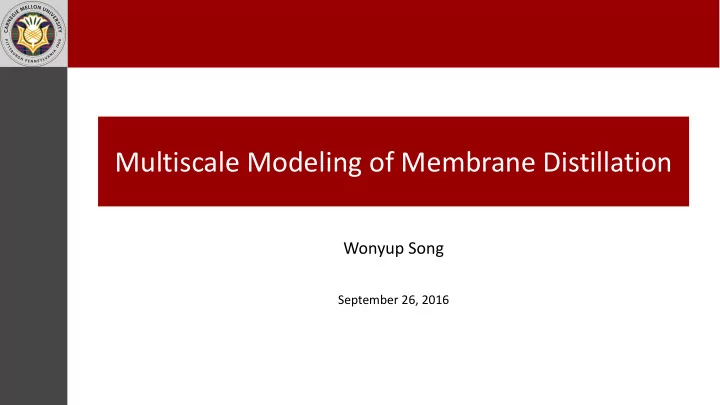

Multiscale Modeling of Membrane Distillation Wonyup Song September 26, 2016
Essence of Multiscale Modeling Goal: Develop system design criteria via multiscale modeling approach based on Holistic Integrated Multiscale Modeling (HIMM) and optimization (middle-out approach)
Step 1. Lattice Boltzmann Method (LBM) - Centerpiece f i 𝐲 + 𝐟 𝐣 ∆t, t + ∆t − f i (𝐲, t) = − 1 eq 𝐲, t Initialization τ f i 𝐲, t − f i Inter-particle force ( 𝐆 int ) Compute local equilibrium d.f. 𝐆 int = −Gψ 𝐲 w i ψ 𝐲 + 𝐟 𝐣 𝐟 𝐣 2D 3D Adsorption force ( 𝐆 ads ) Collision 𝐆 ads = −G ads ψ 𝐲 w i ψ 𝐲 + 𝐟 𝐣 𝐟 𝐣 2 + G 6 ψ 2 Streaming @ Equilibrium; p = ρc s D3Q19 D2Q9 i = 0 - 18 i = 0 - 8 Boundary Shan-Chen (SC) model ψ ρ = ψ 0 exp − ρ 0 conditions ρ Compute observables Output : ρ , u Convergence criteria
Step 2. Validation of Our LBM Code Results XCT image to simulation (A) Vapor condenses and flows XCT image MATLAB generated structure By controlling the hydrophobicity, we can calculate contact angles - Obtain cohesive energy from equation of state - Obtain adhesive energy from surface-pseudo particle interaction parameter Size: 400 X 500 X 500 Lattice units Streamline
Step 3. Linking Mesoscale LBM & Molecular/Atomistic Model (A) Mesoscale (LBM) (B) Molecular Dynamics H H O Contact angle Si or PVDF Need molecular dynamics/Monte Carlo simulation Force field analysis based on atomistic scale is required to accurately model potential energy in molecular dynamics (A) Mesoscale flow analysis for hydrophobic surface. Water fiber interaction is described by surface-water (pseudo-particle) interaction parameter to analyze contact angle (B) Molecular dynamics is performed to calculate contact angle
Step 3 Case Study - Contact Angle Simulation Using MD Simulation details - 800, 1600, 3200, 6400 molecules - NVT ensemble (Nose-Hoover thermostat) Velocity Verlet algorithm (time interval = 10 -15 s) - - Typical simulation time per data point : 1 week 180° − θ Contact angle : 77° ( θ = 103 °) MD simulation results Parameters Values H-O Bond length 1.0 Å H-O-H Angle 109.47° Atomic charge : Hydrogen +0.4238 e Atomic charge : Oxygen - 0.8476 e O-O L-J distance 3.166 Å O-O L-J energy 0.155 kcal/mol
Step 3 Case Study Linking Molecular & Mesoscale Simulation Both LBM and MD calculations are in Hydrophobicity vs contact angle excellent agreement upon scaling Simulation results (LBM & MD) and experimental data are in excellent agreement For the first time, we obtained relationship between molecular and mesoscale parameters LBM MD 19.35G ads = ϵ surf − 6.56
Step 4 System Level Optimization Currently, in progress Attempts are shown in poster
Conclusion We have developed a novel multiscale model, called HIMM, to provide design criteria using molecular/atomistic input using coarse-grained model and reduced order parameters. Fuel cell & membrane distillations were chosen as the benchmark examples for HIMM, We developed multiphysics LBM code to calculate vapor flux with hydrophobicity as an input. (Step 1&2) For the first time, we calculated contact angle using molecular dynamics & LBM (mesoscale analysis) and linked parameters in the both models. (Step 3) We are capable of simulating/controlling the vapor flux for molecularly complex surfaces. Once multiscale algorithm is fully established, we may be able to provide molecular design criteria for membrane systems. (Step 4)
Recommend
More recommend